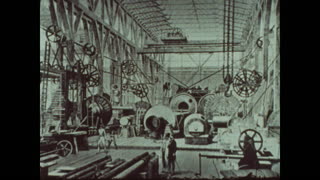“History of Policing in America; All in a Day’s Work” traces the growing professionalism of police work over the years beginning in the 1800’s while exploring the philosophy of law enforcement. It shows how police work requires interpersonal skills as much as muscle. First laws requiring police training were not enacted until the 1960’s. It explores prohibition era laws and relays various technological advances in criminal identification as well as in communication. It is an MIT release and was produced by Jacoby Storm Productions. It features the Norwalk Police Department, the Connecticut Police Academy and the Police Museum in New York. Officers of the Norwalk Police Department walk through the locker room (:08); readying themselves for routine patrol. Two cops slip into a 1978 patrol vehicle (1:11). One officer explains his induction into the force, including a brief test about local authority figures (1:43). His father’s induction began with political appointment (2:08). History begins in the 1850’s with Tammany politicians. The headquarters for the 32 Police Precinct in New York City follows (2:41). Labor protestors march (2:53). 1800’s era mugshots are pictured (3:06). A patrol officer discusses difficult portions of town (3:30). Officers respond to a house call (3:46). One of the first female police officer’s is pictured at the close of the 18th century (4:50). Law enforcement in the wild old west (5:13) consisted of employing the toughest gun fighter. A sheriff deputized posse (5:38) trots over dirt. Motorcycle units (5:55) and a police helicopter (5:58) signify the advancements in transportation leading to advancements in police work. The industrial revolution (7:00) ramped up the need for a regular police force. Change began in London. The London Metropolitan Police Force is pictured in 1829 (7:31) founded by Sir Robert Peel. One of his principles included the minimum use of force (8:06). Police watch a rowdy gang from within a patrol car (8:39). Police use effort to calm perpetrators (9:20). Chicago’s Police Department is a traditionally violent police force (9:57). Riots erupt in summer 1968 (10:21); known as “Chicago 68”. Chicagoans throw smoke bombs over a green parkway; Chicago city scrapers rise in the background (10:14). Police grip up a young woman’s head of hair (10:28). The Chicago Police Department trains on crowd control (10:44). 1959 saw the first law requiring police training and 1972 saw national standards and goals for police training established (10:55). A ten week training course is featured over the criminal justice system at the Connecticut Police Academy (11:14). The shot zooms in on a vintage IBM system (11:30). Film was introduced as a viable tool for training (11:46). The training group watches footage recorded (12:09). August Vollmer (12:29); Chief of Police of Berkeley California, was considered the father of modern law enforcement. He introduced work with lie detectors (12:59), radio communication and pioneered the use of automobiles (13:04). The FBI seal of the Department of Justice follows (13:09). J. Edgar Hoover and the FBI later assisted Vollmer (13:22). Aerial shots show the FBI Academy in Stafford County, VA (13:40). In 1896, the International Association of Chiefs of Police set up clearing house for criminal records (13:44). Officers look over images of fingerprints (13:52). Military police pat down prisoners (14:27). A traffic cop guides (14:39) bustling vehicles. Narration explains how communication is linked at the FBI National Crime Information Center (14:53). Jurisdictions (15:00) between counties, state and local police are discussed (15:07). Specialized training (15:17) courses include hostage negotiation, ICT or stress management. An officer uses hypnosis (15:42). Sir Robert Peel’s theories on police work is discussed (15:59). Reformist movements follow, Reverend Charles Parkhurst (16:35) pushed for change in Tammany hall. The Prohibition Era fueled organized crime (17:03). Police dump barrels of booze into the streets (17:04). The shift in technology over the years is visualized (17:29). Police learn how to use sign language (18:34). An officer discusses the dark side of police work (19:29). Sirens swing on for a traffic stop (20:27) with a 1979 Volkswagen. The film was directed by Frank Jacoby (21:27) and produced by Jacoby/Storm Productions Inc. (21:32).
This film is part of the Periscope Film LLC archive, one of the largest historic military, transportation, and aviation stock footage collections in the USA. Entirely film backed, this material is available for licensing in 24p HD, 2k and 4k. For more information visit http://www.PeriscopeFilm.com


